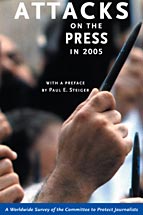New York, February 14, 2006–Highlighting the global nature of its press freedom advocacy work, the Committee to Protect Journalists today released its annual press freedom survey Attacks on the Press in four cities: Bangkok, Cairo, London and Washington, D.C.
Reported and written by CPJ staff, Attacks on the Press is widely recognized as the most authoritative source of information on press conditions worldwide, and features a preface by Paul E. Steiger, CPJ chairman and managing editor of The Wall Street Journal, and an introduction by CPJ Executive Director Ann Cooper.
Attacks on the Press recounts a violent year in Iraq, which has become the deadliest conflict for journalists in a quarter-century.
Among trends documented in the latest edition are the assassinations of journalists in the Middle East, a surge in government persecution in Africa, the widespread jailing of reporters from China to Cuba, and pervasive self-censorship in Latin America.
CPJ’s annual survey details hundreds of cases of media repression in dozens of countries, including murders, assaults, imprisonments, censorship, and legal harassment.
Attacks on the Press reports on several trends:
- Self-censorship is widespread in areas of Mexico, Colombia, and Brazil where crime and corruption are strong and government institutions weak. “Burning issues such as the pillaging of natural resources, trafficking in drugs and people, and corruption are deprived the oxygen of public debate,” Carlos Lauría writes.
- Assassinations of journalists in Lebanon, Libya, and Iraq have fundamentally changed reporting in the Middle East, where governments traditionally used nonviolent methods to quell dissent. Now, writes Joel Campagna, “A growing number of attacks against journalists have been carried out with impunity, forcing independent journalists across the region to ponder the consequences of what they write.”
- The U.S. government’s policy of close cooperation with Eurasia’s authoritarian leaders has undermined independent reporting in nations such as Russia, Kazakhstan, and Uzbekistan. “At the same time, the administration’s antiterrorism agenda has made it easier for the region’s resourceful authoritarian leaders to justify repressive media policies in the name of security,” Alex Lupis writes.
- More Asians are getting their news on the radio than ever before because of an explosion of community stations and an infusion of international financing. But as radio becomes powerful, challenges emerge. “In Nepal and Thailand, leaders retaliated with crackdowns on radio stations, while radio journalists in Afghanistan and the Philippines frequently faced threats and violence because of their reporting,” writes Abi Wright.
- Elections in Africa offered very different lessons in democracy and the press. While Burundian media played a major role in an election that led to the country’s most representative government in years, Julia Crawford writes that, “In Zimbabwe, the independent media have been so restricted by an increasingly repressive government that elections were no victory for democracy.”
- Throughout the world, CPJ staff identified new trouble spots: in Nepal, where a royal coup led to vast censorship; in Uzbekistan, where the massacre of citizens by government troops was followed by a brutal press crackdown; in Ethiopia, where journalists were put on a “wanted list” and jailed to quell dissent; and in Yemen, where a surge in violent attacks threatened the lively media.
Other important facts in CPJ’s Attacks on the Press include:
- A total of 47 journalists were killed worldwide as a direct result of their work. More than 100 journalists have lost their lives in the line of duty in the last two years, making it the deadliest such period in a decade.
- Iraq was the most dangerous place for journalists in 2005, with 22 journalists killed in the line of duty. Iraq also became the deadliest war for journalists since CPJ was founded in 1981, surpassing the 58 killed between 1993 and 1996 in the Algerian conflict.
- Murder was the leading cause of work-related deaths among journalists. More than three-quarters of the journalists killed on duty were targeted for murder, continuing a long-term trend documented by CPJ.
- Continuing another trend, the killers of journalists usually go unpunished. In about 90 percent of cases in 2005, CPJ found, the murders were carried out with impunity.
- A total of 125 journalists were imprisoned by 24 countries for their work, figures that reflected increases from the year before. Four countries account for more than two-thirds of the total: China with 32 journalists behind bars, Cuba with 24, Eritrea with 15, and Ethiopia with 13.
- In at least 78 cases, CPJ found, journalists were imprisoned on broad “antistate” charges, such as sedition, subversion, divulging state secrets, and working against the interests of the state.
Despite these assaults on the press, CPJ found several important achievements. International advocacy efforts, including those waged by CPJ, helped win the early release of a number of imprisoned journalists, notably Burmese documentary filmmaker Aung Pwint and Yemeni editor Abdel Kareem al-Khawaini.
In the Philippines, where rural radio journalists had been killed in record-breaking numbers since 2000, the government reversed its longtime denial of the problem and stepped up its law enforcement efforts. A landmark conviction followed, along with hopes that the killings would subside.
